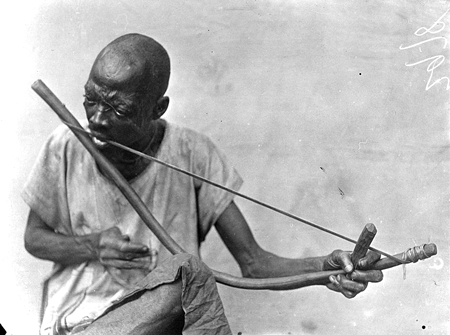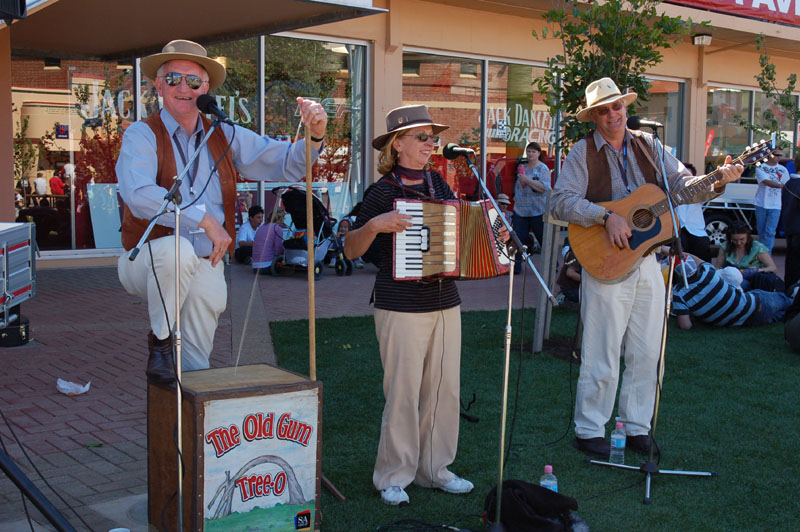|
Washtub Bass
The washtub bass, or gutbucket, is a stringed instrument used in American folk music that uses a metal washtub as a resonator. Although it is possible for a washtub bass to have four or more strings and tuning pegs, traditional washtub basses have a single string whose pitch is adjusted by pushing or pulling on a staff or stick to change the tension. The washtub bass was used in jug bands that were popular in some African American communities in the early 1900s. In the 1950s, British skiffle bands used a variant called a tea chest bass, and during the 1960s, US folk musicians used the washtub bass in jug band-influenced music. Variations on the basic design are found around the world, particularly in the choice of resonator. As a result, there are many different names for the instrument including the "gas-tank bass", "barrel bass", "box bass" (Trinidad), "bush bass" (Australia), "babatoni" (South Africa), "tanbou marengwen" (Haiti) "tingotalango" (Cuba), " tulòn" (Italy), "laund ... [...More Info...] [...Related Items...] OR: [Wikipedia] [Google] [Baidu] |
Ground Bow
The musical bow (bowstring or string bow, a subset of bar zithers) is a simple string instrument used by a number of South African peoples, which is also found in the Americas via slave trade. It consists of a flexible, usually wooden, stick 1.5 to 10 feet (0.5 to 3 m) long, and strung end to end with a taut cord, usually metal. It can be played with the hands or a wooden stick or branch. It is uncertain if the musical bow developed from the hunting bow, though the San or Bushmen people of the Kalahari Desert do convert their hunting bows to musical use. Types of bow include mouth-resonated string bow, earth-resonated string bow, and gourd-resonated string bow. History There is speculation that the hunting bow may have been used as a musical instrument from as early as circa 13,000 B.C. Henri Breuil surveyed the Trois Frères in France caves and made an engraving that attempted to reproduce a c. 13,000 B.C. cave painting into a black-and-white lithograph engraving ... [...More Info...] [...Related Items...] OR: [Wikipedia] [Google] [Baidu] |
Bush Band
A bush band is a group of musicians that play Australian bush ballads. A similar bush band tradition is also found in New Zealand. Instruments In addition to vocals, instruments featured in bush bands may include fiddle, accordion, guitar, banjo, mandolin, concertina, harmonica, lagerphone, bush bass ( tea chest bass) or double bass, tin whistle, and bodhrán. Less common are the piano, bones, barcoo dog (a sheep herding tool used as a sistrum), spoons, and musical saw. Although not traditional, electric bass guitar or electric guitar have occasionally been used since the 1970s. Repertoire and function Bush bands play music for bush dances, in which the dance program is usually based on dances known to have been danced in Australia from colonial times to the folk revival in the 1950s. Contemporary dances, set in the traditional style, are also featured at bush dances. Some popular traditional bush dances are Stockyards, Haymaker's Jig, Galopede, Brown Jug Polka, ... [...More Info...] [...Related Items...] OR: [Wikipedia] [Google] [Baidu] |
New Zealand
New Zealand ( mi, Aotearoa ) is an island country in the southwestern Pacific Ocean. It consists of two main landmasses—the North Island () and the South Island ()—and over 700 smaller islands. It is the sixth-largest island country by area, covering . New Zealand is about east of Australia across the Tasman Sea and south of the islands of New Caledonia, Fiji, and Tonga. The country's varied topography and sharp mountain peaks, including the Southern Alps, owe much to tectonic uplift and volcanic eruptions. New Zealand's capital city is Wellington, and its most populous city is Auckland. The islands of New Zealand were the last large habitable land to be settled by humans. Between about 1280 and 1350, Polynesians began to settle in the islands and then developed a distinctive Māori culture. In 1642, the Dutch explorer Abel Tasman became the first European to sight and record New Zealand. In 1840, representatives of the United Kingdom and Māori chiefs ... [...More Info...] [...Related Items...] OR: [Wikipedia] [Google] [Baidu] |


